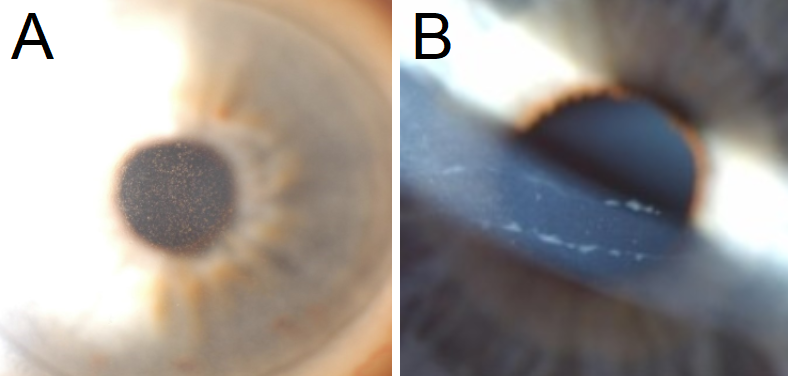[1]
Lin ZN, Chen J, Cui HP. Characteristics of corneal dystrophies: a review from clinical, histological and genetic perspectives. International journal of ophthalmology. 2016:9(6):904-13. doi: 10.18240/ijo.2016.06.20. Epub 2016 Jun 18
[PubMed PMID: 27366696]
Level 3 (low-level) evidence
[2]
Krachmer JH. Posterior polymorphous corneal dystrophy: a disease characterized by epithelial-like endothelial cells which influence management and prognosis. Transactions of the American Ophthalmological Society. 1985:83():413-75
[PubMed PMID: 3914130]
[3]
Ahn YJ, Choi SI, Yum HR, Shin SY, Park SH. Clinical Features in Children with Posterior Polymorphous Corneal Dystrophy. Optometry and vision science : official publication of the American Academy of Optometry. 2017 Apr:94(4):476-481. doi: 10.1097/OPX.0000000000001039. Epub
[PubMed PMID: 28009792]
[4]
Cibis GW, Tripathi RC. The differential diagnosis of Descemet's tears (Haab's striae) and posterior polymorpous dystrophy bands. A clinicopathologic study. Ophthalmology. 1982 Jun:89(6):614-20
[PubMed PMID: 6981787]
[5]
Rodrigues MM, Waring GO, Laibson PR, Weinreb S. Endothelial alterations in congenital corneal dystrophies. American journal of ophthalmology. 1975 Oct:80(4):678-89
[PubMed PMID: 1080955]
[6]
Bourgeois J, Shields MB, Thresher R. Open-angle glaucoma associated with posterior polymorphous dystrophy. A clinicopathologic study. Ophthalmology. 1984 Apr:91(4):420-3
[PubMed PMID: 6609327]
[7]
Grayson M. The nature of hereditary deep polymorphous dystrophy of the cornea: its association with iris and anterior chamber dygenesis. Transactions of the American Ophthalmological Society. 1974:72():516-59
[PubMed PMID: 4549335]
[8]
Liskova P, Gwilliam R, Filipec M, Jirsova K, Reinstein Merjava S, Deloukas P, Webb TR, Bhattacharya SS, Ebenezer ND, Morris AG, Hardcastle AJ. High prevalence of posterior polymorphous corneal dystrophy in the Czech Republic; linkage disequilibrium mapping and dating an ancestral mutation. PloS one. 2012:7(9):e45495. doi: 10.1371/journal.pone.0045495. Epub 2012 Sep 25
[PubMed PMID: 23049806]
[9]
Consorti A, Sansevero G, Torelli C, Berardi N, Sale A. From Basic Visual Science to Neurodevelopmental Disorders: The Voyage of Environmental Enrichment-Like Stimulation. Neural plasticity. 2019:2019():5653180. doi: 10.1155/2019/5653180. Epub 2019 May 6
[PubMed PMID: 31198418]
[10]
DeRespinis PA, Norden RA, Rispoli LC. Posterior polymorphous dystrophy associated with astigmatism and amblyopia in children. Journal of refractive surgery (Thorofare, N.J. : 1995). 1996 Sep-Oct:12(6):709-14
[PubMed PMID: 8895127]
[11]
Al-Amry M, Khan AO. Unilateral posterior polymorphous corneal dystrophy associated with ipsilateral anisometropic amblyopia. Journal of pediatric ophthalmology and strabismus. 2013 Oct 29:50 Online():e55-7. doi: 10.3928/01913913-20131022-02. Epub 2013 Oct 29
[PubMed PMID: 25313553]
[12]
Chaurasia S, Mittal R, Bichappa G, Ramappa M, Murthy SI. Clinical characterization of posterior polymorphous corneal dystrophy in patients of Indian ethnicity. International ophthalmology. 2017 Aug:37(4):945-952. doi: 10.1007/s10792-016-0360-y. Epub 2016 Sep 22
[PubMed PMID: 27658681]
[13]
Lisch W. [Corneal dystrophy (CD)-induced pain and visual impairment in childhood]. Klinische Monatsblatter fur Augenheilkunde. 2013 Jun:230(6):582-6. doi: 10.1055/s-0032-1328312. Epub 2013 Jun 21
[PubMed PMID: 23794427]
[14]
Rodrigues MM, Phelps CD, Krachmer JH, Cibis GW, Weingeist TA. Glaucoma due to endothelialization of the anterior chamber angle. A comparison of posterior polymorphous dystrophy of the cornea and Chandler's syndrome. Archives of ophthalmology (Chicago, Ill. : 1960). 1980 Apr:98(4):688-96
[PubMed PMID: 6989348]
[15]
Hermina Strungaru M, Ali A, Rootman D, Mireskandari K. Endothelial keratoplasty for posterior polymorphous corneal dystrophy in a 4-month-old infant. American journal of ophthalmology case reports. 2017 Sep:7():23-26. doi: 10.1016/j.ajoc.2017.05.001. Epub 2017 May 4
[PubMed PMID: 29260073]
Level 3 (low-level) evidence
[16]
Sorkin N, Einan-Lifshitz A, Boutin T, Showail M, Borovik A, Chan CC, Rootman DS. Descemet membrane endothelial keratoplasty in iridocorneal endothelial syndrome and posterior polymorphous corneal dystrophy. Canadian journal of ophthalmology. Journal canadien d'ophtalmologie. 2019 Apr:54(2):190-195. doi: 10.1016/j.jcjo.2018.05.012. Epub 2018 Aug 23
[PubMed PMID: 30975342]
[17]
De Maria M, Iannetta D, Moramarco A, Fontana L. Iridocorneal endothelial syndrome in a patient with keratoconus - a case report. BMC ophthalmology. 2019 Nov 11:19(1):221. doi: 10.1186/s12886-019-1215-x. Epub 2019 Nov 11
[PubMed PMID: 31711443]
Level 3 (low-level) evidence
[18]
Matsumoto K, Weber PA, Makley TA Jr. Posterior polymorphous dystrophy--a histopathologic presentation. Annals of ophthalmology. 1988 Oct:20(10):388-90, 393
[PubMed PMID: 3061350]
[19]
Moroi SE, Gokhale PA, Schteingart MT, Sugar A, Downs CA, Shimizu S, Krafchak C, Fuse N, Elner SG, Elner VM, Flint A, Epstein MP, Boehnke M, Richards JE. Clinicopathologic correlation and genetic analysis in a case of posterior polymorphous corneal dystrophy. American journal of ophthalmology. 2003 Apr:135(4):461-70
[PubMed PMID: 12654361]
Level 3 (low-level) evidence
[20]
Aldave AJ, Ann LB, Frausto RF, Nguyen CK, Yu F, Raber IM. Classification of posterior polymorphous corneal dystrophy as a corneal ectatic disorder following confirmation of associated significant corneal steepening. JAMA ophthalmology. 2013 Dec:131(12):1583-90. doi: 10.1001/jamaophthalmol.2013.5036. Epub
[PubMed PMID: 24113819]

